Unfortunate Skin Tofu
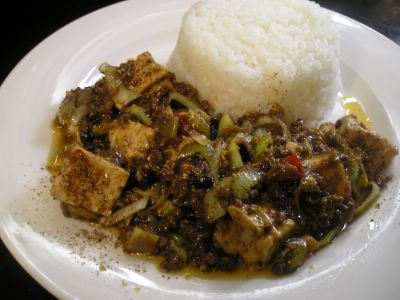
Does your mother have bad skin?
Is it so bad that you've often wondered why someone hasn't created a spicy hot recipe with tofu and beef to extol your mother's bad skin virtues?
If so, you are not alone.
 The following recipe is a Chinese restaurant staple. It's called ma po dou fu ("pock-marked Mother Chen's bean curd) and is a regional dish from the Sichuan province of China, which you may know as producing some of the hottest Chinese food around, such as Kung Pao Chicken. Unlike traditional Cantonese cuisine, Sichuan cuisine liberally uses spices to flavor a dish, as well as using beef instead of pork for many other dishes.
The following recipe is a Chinese restaurant staple. It's called ma po dou fu ("pock-marked Mother Chen's bean curd) and is a regional dish from the Sichuan province of China, which you may know as producing some of the hottest Chinese food around, such as Kung Pao Chicken. Unlike traditional Cantonese cuisine, Sichuan cuisine liberally uses spices to flavor a dish, as well as using beef instead of pork for many other dishes.Often in American Chinese restaurants, when one is served Mapo Tofu, what one recieves isn't the Sichuan dish, but a Cantonese interpretation of the dish (actually, on the menu it's usually called something else, but if you ask for ma po dou fu, you'll get it). For one, true Mapo Tofu uses ground beef, not ground pork. Second, dried red chilis are used for heat, not any other kind of chili (I've been served the dish with jalepenos). Third, Sichuan peppercorns are used liberally in the dish to create the "hot-numbing" flavor which is one of the many signature flavors of Sichuanese food.

Since finding this classic dish in its authentic form is so hard to find in the U.S., I've decided on making it from scratch using the fabulous new cookbook by author Fuchsia Dunlop. The book is titled "Land of Plenty: Authentic Sichuan Recipes Personally Gathered In the Chinese Province of Sichuan" (2003, W.W. Norton & Company Inc.). Even though it's checked out from the library, this one is definitely going on my wish list. So far I've tested the Mapo Tofu and Kung Pao Chicken recipes and, boy, are they hot, and spicy, and flavorful, and did I say hot? Something I also love about this recipe that may turn off some Westerners, is the abundant use of oil in cooking which, along with the corn starch, makes a silky, smooth, and yes oily, sauce.
Drool...
Oh, wait, heart attack!
No, I'm fine.
Drool...
According to the book, Old Pock-Marked Mother Chen (you just gotta love her!) was the wife of a Qing Dynasty restauranteur who would prepare this oily, spicy dish for laborers, who would lay down their loads of cooking oil, to eat while on their way to the city's markets.
I usually don't gush over cookbooks, but Fuchsia has written a book that has opened up a whole world of cuisine that for the most part has barely travelled beyond China's borders. For that she should be praised! (Although after a few of these hot and spicy dishes, your nether-regions may not be so quick to salute!)
"Land of Plenty" is a must for anyone who seriously loves to eat and cook Chinese food, especially those who yearn to seek out the authentic flavors of the dishes we are so familiar with, yet aren't really.
OK, my only one complaint is this picture:
 This is the photo in the book of the "ma po dou fu" recipe. As you have seen and will see from my results, it looks nothing like that.
This is the photo in the book of the "ma po dou fu" recipe. As you have seen and will see from my results, it looks nothing like that.One ingredient used in this recipe is the famous (or infamous) Sichuan peppercorn, which for many people who have heard of it, only few have seen it, let alone used it in cooking. Those who have seen it perhaps may have only seen it many, many years ago, or perhaps only recently. This is due to the fact that the Sichuan peppercorn is not really a "peppercorn", but a member of the citrus family. For decades, all raw citrus products have been banned from import into the United States, including Sichuan peppercorns. The ban against the peppercorns wasn't actually enforced until a few years ago, when the only peppercorns you could find were smuggled in by means I don't want to know about (and here we are back to the nether-regions...).
Currently, Sichuan peppercorns are allowed into the US, but only if they've been brought to a temperature of 160 degrees before export out of China. How this affects the quality and freshness of the peppercorns, I don't know, and so far I haven't heard of any professional studies proving or disproving anything.
What I do know is that the fragrance and flavor Sichuan peppercorns bring to a dish is like no other I have ever encountered before. And yes, it does numb your mouth, which is just weird. You can find Sichuan peppercorns in most places in Chinatown that sell spices. However, sometimes they are unlabeled. You can try asking for Sichuan peppercorns, but sometimes they are called "prickly ash berries". One dollar will buy you enough to last a long time.
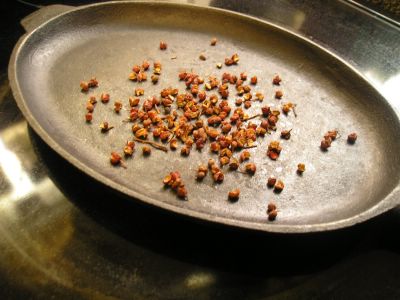
To use Sichuan peppercorn in a dish, always toast the peppercorns at a medium temperature just until they start to smoke and become fragrant. I find doing this to be pretty easy by toasting them in a cast-iron skillet, giving them a good shake every once and a while. After they've been toasted, grind them up in a spice grinder (or clean coffee grinder) until they are powdered. After that, you're ready to use them. However, if you aren't using the spice anytime soon, you should leave the peppercorns untoasted and unground until you are ready to use the spice.
The other crucial ingredients to use in this recipe are fermented black beans and chili bean sauce. These items also can be hard to find and I've even found locating them in Chinatown to be slightly difficult (but I'm still just getting my feet wet there).

The fermented black beans are common in many Chinese dishes and sauces and have a very characteristic flavor to them. Any dish that calls for them or a sauce made from them (the most common is the garlic black bean sauce) would be impossible to make with their ommision. The chili bean sauce (you guessed it) is also made from fermented black beans and, that's right, chilis. However, it's not as hot as you might believe, but it's still pretty spicy. I found these two ingredients at a market on Stockton Street near Broadway. The beans were 89 cents (and more than I could ever use), while the sauce (which I could use on anything!) was $1.89. Make sure you look for the expiration date on the beans!
If you don't live near a Chinatown, here are some places on the web that you can find these ingredients (Note: I found them doing a Google search – I can't vouch for their service or quality).
Sichuan Peppercorns
Fermented Black Beans
Chili Black Bean Sauce
The only other comment I have to add about this recipe is that, in the future, I think I'm going to make it with a little more tofu than the recipe calls for. This is just my personal taste. Also, I used regular dried red chilis for this dish, but DANGER, DANGER, WILL ROBINSON, because you can really go overboard quickly. I suggest using only a very small amount (and with the seeds removed) the first go around. Trust me, I found out the hard way with the Kung Pao Chicken! (and we're back to the nether-regions...)
Last night was my third attempt at making this dish in the last 2 weeks, and written down here is the recipe, as translated by me (don't worry, no significant deviations).
Ma Po Dou Fu
Ingredients:
1 block of tofu (1 pound)
2 small or one large leek
½ cup of peanut oil
½ pound of ground beef
2 ½ tablespoons of chili bean sauce (also called "paste")
1 tablespoon of fermented black beans
2 tablespoons of ground dried chilis (I add them whole and in quanties I know will be comfortable to eat)
1 cup of stock (I use beef, but the recipe calls for chicken)
1 teaspoon of white sugar
2 teaspoons of light soy sauce
salt to taste
4 tablespoons of cornstarch diluted with 6 tablespoons of cold water
½ teaspoon of ground Sichuan peppercorn
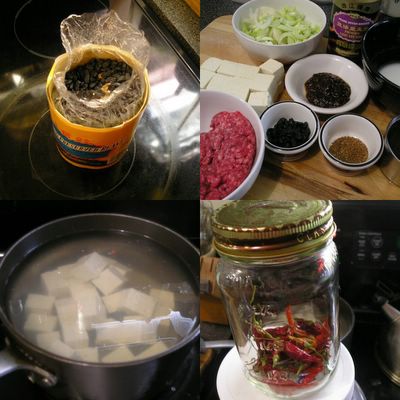
1. Cut the bean curd into 1" cubes and leave to steep in very hot (almost boiling) slightly salted water. Slice the leeks or leek at an angle into thin slices.
2. Add the oil to a wok, a cast-iron pan, or a dutch oven and heat over high temperature, just until it begins to smoke. Then add the minced beef (or ground beef) and sautee until crispy but not dry.
3. Turn the heat down to medium and then add the bean sauce and stir-fry. After 30 seconds, add the dry red chilis and fermented black beans and fry for another 30 seconds.
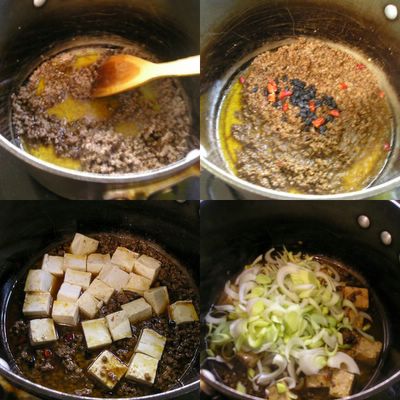
4. Then add the stock, stir well, and then add the drained tofu. Mix gently. Simmer for 5 minutes or until the tofu has absorbed some of the sauce.
5. Next add the leeks and stir in. When they are just cooked, add the cornstarch a little at a time. You may not have to use the whole amount. Only use enough so that the sauce clings to the meat and the tofu. Finally, spoon everything into a large bowl or serving dish (or plate individually) and sprinkle the Sichuan peppercorn spice over the top.
Serve with hot tea and lots of towels to wipe your forehead with!
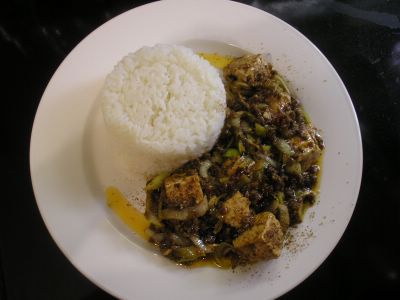
k.
 Hello and welcome. This food blog is based in San Francisco and I'm Kevin, the guy who writes it.
You may know me from my brief, but violent and cracked out, appearance on COPS. Actually, that wasn't me - he didn't even look like me.
I'm more than happy to entertain you, but please don't be so shy. You can comment below or contact me personally at baconprss at yahoo dot com. Oh, and I like to eat sometimes.
Hello and welcome. This food blog is based in San Francisco and I'm Kevin, the guy who writes it.
You may know me from my brief, but violent and cracked out, appearance on COPS. Actually, that wasn't me - he didn't even look like me.
I'm more than happy to entertain you, but please don't be so shy. You can comment below or contact me personally at baconprss at yahoo dot com. Oh, and I like to eat sometimes.

7 Comments:
Hi,
I hope you don't think I'm crapping on your blog (because I really think this is a great site), but I think you either forgot a step or have a slightly wrong ingredient. The final dish should look a lot redder, just like the one in the cookbook. Granted I wasn't there, but from the photos it looks like the chili paste is missing. In step 3, the overall color of the dish should be notably red from the addition of chili paste.
Maybe you have a different kind of chili paste? It should be bright red and have the consistency of tomato paste. I usually get the ones that say "Chili Paste with Garlic", and I would get the Chinese brands for this dish. There are lots of things called chili paste in the Asian aisle, but several of them aren't quite right for this dish. If you taste it, the chili paste should be mostly salty, not sweet at all.
A couple of other things...I think the recipe calls for too much leek. It should be more of a garnish. And if you don't feel like using leek, plain old green onions are very commonly used. One other thing, I prefer this dish with pork instead of beef.
Sorry to mention so many tweaks, but I think you might end up a dish more like my Szechuan grandmother would make.
Howie,
Don't be sorry! I appreciate the feedback and take it to heart!
You're right, I think the sauce I used was wrong. I'm going to try a few different ones and see which one works best.
When I've had Ma Po bean curd in restaurants it's how you describe, with green onions as a garnish. Again, I'll have to try both and see which one I like best. (also, many of the restaurants here add peas and mushrooms, and sometimes delete the meat altogether).
Like I said in the post, I definitely would prefer a more tofu to meat equation, whether it's ground beef or pork.
Thanks for the great advice and glad you like the blog!
k.
Hi,
I forgot to mention, but I really like the Land of Plenty cookbook. It's probably my favorite Chinese cookbook. For some reason, Chinese people (or maybe just my mom and grandma) are kind of lax about giving exact measurements and instructions. It makes sense that a Westerner would document it really well.
By the way, I think you're right about the meat to tofu ratio. I just checked my mom's beatup Pei Mei cookbook, and she uses only 1/4 lb. of pork. I'll list the full ingredients below, but I actually think they're slightly off (I'd prefer a lot more chili paste):
1 pkg tofu
4 oz ground pork or beef
1 t Garlic chopped
1 T green onion chopped
1 T hot bean paste
1 t szechuan peppercorns, ground
2 T soy sauce
1 t. Salt
2/3 cups stock
1 t sesame oil
I would like to try this, but I don’t think I am going to be able to get Szechuan peppercorns, I live in the UK and my nearest Chinese market is about 50 miles away, they may have them but it’s a bit of a way to travel for one thing. Do you know of anything I could substitute them with?
This is the chilli bean sauce I use by the way (took me months to find somewhere that stocks it)... http://europe.lkk.com/consumer/product_detail.asp?ProductID=31
Hope you have some ideas
Thanks
Jim
Unfortunately there are no substitutions for the fragrance and numbing feeling of Szechuan peppercorns.
You can make the recipe anyway and it will be hot, but you won't have the citrus-y numbing flavor on top of that.
However, there are a lot of spice companies that sell what you're looking for.
Here's one in the UK:
http://www.seasonedpioneers.co.uk/
Note: they list it as Sichuan peppercorns.
The bean sauce you used is from a reputable company, so I'm sure you're fine with what you have.
Happy Chinese cooking!
k.
Thanks for the link, ordered them and it arrived this morning, nice fast delivery.
Most of my family are not overly keen on tofu, so I was wondering if you thought it would work if I substituted it with chicken breast, I would probably poach it prior to adding chunks to the wok. I will of course try it with tofu first though.
I don’t mind changing recipes but sometimes the results aren't quite what you expect, plus I’m not that experienced a cook so I thought I would ask before trying it.
Thanks
Jim
I followed the recipe from the book and ended up with a similar picture to that in the book. Take a look at my photos. http://new.photos.yahoo.com/samisha/album/576460762384693285
Post a Comment
<< Home